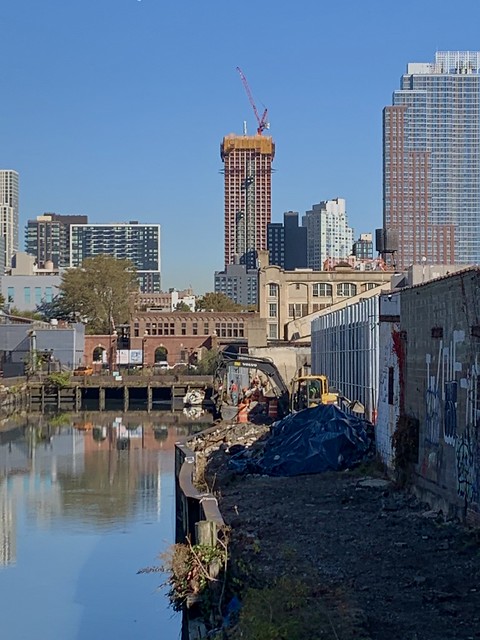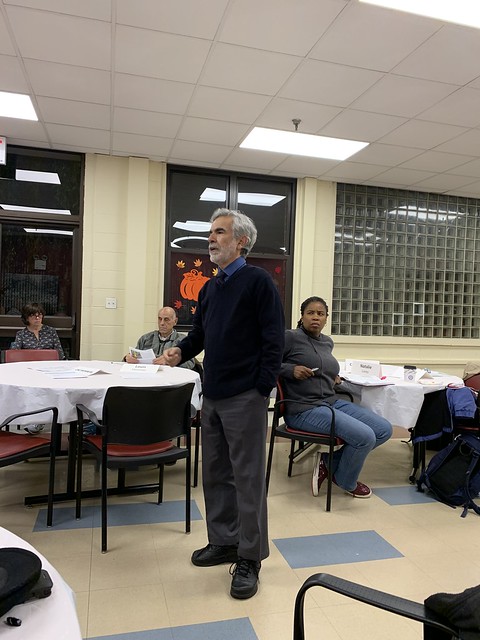Gowanus Canal Community Advisory Group
Christos Tsiamis
EPA Region 2 Gowanus Canal Project Manager
EPA Fact Sheet on Fulton Bulkhead Barrier Wall
The Gowanus Canal Superfund Community Advisory Group gathered this past Tuesday for its October General Meeting to receive an update on work currently performed in and around the canal under the supervision of the Environmental Protection Agency.
Christos Tsiamis, the EPA project manager for the Gowanus Canal Superfund gave the CAG an overview on the Fulton Bulkhead Barrier Wall Construction at the head of the canal. The sealed wall will serve as an environmental barrier, preventing liquid coal tar from the former Fulton Manufactured Gas Plant from recontaminating the canal after the Superfund clean-up is completed. The work is being done by National Grid contractors and consists of "880 feet of steel sheet piling to be placed in front of the bulkheads along the eastern side of the Gowanus Canal and will extend from the canal head end to the Union Street Bridge."
Work on the wall began in late August 2019 and has been progressing as planned, except for a small delay caused by repairs to the Union Street Bridge. However, the NY City Department of Transportation has assured EPA that it will open the bridge so that barges carrying material for the wall construction can get through. EPA does not project a significant delay because of the bridge repair.
"The conclusion is that we are on track to finish that wall by August 2020," Tsiamis told the CAG.
DoT at work on the Union Street Bridge this morning
Recently, the group of Potentially Responsible Parties (Polluters) handed EPA 90% of the design for the clean-up of the upper portion of the canal. EPA is in the process of reviewing in detail all aspects of the canal design and will send back comments to the PRPs shortly.
"I mention this because we have had some differences with the PRPs, in particular National Grid and their contractor in regards to the approach of that particular clean-up. We had objections to the schedule that they were presenting." Tsiamis stated.
EPA believes that the dredging at the head of the canal can begin in August/ September 2020, whereas National Grid is pushing for a start date in May 2021.
"We still believe that the head of the canal clean-up can start by sometime in 2020. We are looking carefully at the design that they have submitted and we will let you know how things are going at the next CAG meeting." Tsiamis added.
Regarding the two retention tanks that NY City's Department of Environmental Protection is mandated to build to keep Combined Sewer Overflow out of the Canal during rain events (one 8 million gallon tank at the head of the Canal and a 4 million gallon tank on the Salt Lot on Second Street), Tsiamis mentioned that the City has just provided EPA with the 90% design for the larger of the two tanks. Again, the Agency is currently reviewing the plans.
"I am also looking forward to resuming work on the middle of the canal retention tank," he told the CAG.
When asked how DEP had reacted to a recent decision by EPA Region 2 Regional Administrator Lopez to disallow the City to shift from constructing the two CSO tanks to a tunnel, Tsiamis answered: "That matter is finished on the part of the EPA. and we are moving forward."
"The EPA has spent nearly a year and a half and lots of resources looking at what had been presented to us. We offered our input to the Administrator. He considered everything and he made his decision. That decision is very well summarized in the letter that was sent by him to [DEP's] Commissioner."
{see letter below}
"We now have to really focus all of our efforts on getting on with the work, finalizing the design, initiate the design, hopefully in an accelerated fashion, and cleaning up the canal, which is not a small task.," Tsiamis concluded.
Letter from EPA Regional Administrator Lopez To DEP Commissioner Sapienza
regarding CSO tunnel decision.



















.JPG)

3 comments:
Thank you for this excellent update. I assume you attended the meeting. I have a question that you may be able to answer. In rejecting the water tunnel solution, I read that the EPA stated something to the effect that property owners will need to do more to control waste water.
Have any of these meetings included a discussion of what would be required of new buildings to retain either waste or rain water to reduce the flow of raw sewerage into the canal?
I read this week that two property owners had bought up contiguous sites on Union and President streets along 3rd Avenue. The purchase price was approximately $100 million. The only way that purchase price makes sense is if you intend to construct very large (tall) buildings.
It seems fair and perhaps a viable solution, for the city and/or the EPA to require these large buildings to take a piece of their property and install large tanks within each building to eliminate the risk that raw sewerage from the building runs directly into the canal.
Thank you for your excellent reporting.
Hi Anon, Yes, I attended the meeting. The question you asked did not come up this time, but at the September CAG meeting.
It is clear that DEP is free to build larger tanks both at the head of the canal and on the Second Street site. We should remember that DEP negotiated the size of the 8 and 4 million gallon tanks DOWN with the EPA in 2012-2013. EPA had originally suggested a 12 and 6 million gallon tank just to accommodate CURRENT conditions.
The EPA will be very protective of its clean-up once the canal has been dredged and capped. The Agency mentioned that it will look at each new Gowanus development individually to make sure that it does not recontaminate the canal with CSO discharges.
Asking developers to retain some of the rainwater on their site through green roofs and gardens, asking them to have their own retention tanks... all solutions are on the table and will be considered by EPA.
One thing seems sure: 2o,ooo new residents using showers, washing machines, dishwashers and toilets perhaps can't be accommodated in Gowanus, especially during rain events.
And I am not even going into the fact that it is a FEMA Flood Zone A and that Global Warming will not improve things.
New buildings must retain storm water - that's NYC code regardless of if you are a site of a PRP or any other property in most of Brooklyn.
EPA has NO jurisdiction over new building permits so the statement that EPA will be protective is NOT true. The recently cleaned 4th St. basin (by EPA) received a fresh set of contamination during yesterday's rainfall. After the EPA is done, our Canal will continue to be contaminated when it rains.
Post a Comment